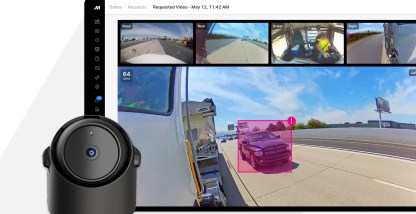As a commercial fleet driver, you want to be out on the road making trips and doing your job. Having to prepare for the Department of Transportation (DOT) physical exam can feel like an unwanted distraction.
That’s why we’ve pulled together all the information you need to know in this guide to the basics of the DOT physical exam.
What is the DOT physical exam?
Commercial driver medical exams are required by the Federal Motor Carrier Safety Administration (FMCSA). The DOT physical exam is described to medical professionals doing the testing as “a critical element of the FMCSA safety program…focused on reducing crashes, injuries, and fatalities involving large trucks and buses.”
According to the FMCSA, “approximately 6 to 7 million commercial motor vehicle (CMV) drivers are required by law to comply with FMCSA physical qualification standards.” That means certified medical examiners are performing more than 3 million physical examinations annually.
Who needs a DOT medical exam?
The DOT physical exam is mandatory for drivers who operate vehicles that
- Have a GVWR of 10,000 pounds or more and are engaged in interstate commerce
- Carry hazardous materials (HAZMAT)
- Are capable of carrying more than 15 occupants, or eight occupants if the driver is a paid employee
What do doctors check for during the DOT physical exam?
The aim of the exam is to determine a driver’s medical fitness for duty. The medical examiner is aware of stressful scenarios for commercial drivers, including the type of route, work schedule, environment, and cargo. With these in mind, the medical professional is looking to determine that a driver can successfully
- Stay alert when driving
- Control the steering wheel
- Use side mirrors
- Manipulate dashboard switches and controls
- Shift gears
- Enter and exit the vehicle
- Couple and uncouple trailers
- Load, secure, and unload cargo
- Perform vehicle checks
The examiner’s role is to determine “acceptable risk.” As the FMCSA puts it, the examiner’s “fundamental obligation during the physical assessment is to establish whether a driver has a disease or disorder that interferes with the ability to safely operate a CMV, increases the risk for sudden death, or increases the risk for the onset of gradual or sudden incapacitation, thus endangering public safety.”
What does the DOT physical exam consist of?
To understand how to pass the DOT physical exam, you’ll need to know, specifically, what it involves.
A health history
You’ll be asked to complete a health history form. If you answer “yes” to any of the questions, the examiner will follow up. The examiner will ask about diagnosis, treatment, and response to treatment. They’ll review and discuss any medications you currently use, or recently used. And they’ll go over potential side effects that may interfere with driving.
A vision test
To pass the vision test, a driver must demonstrate
- Visual acuity of at least 20/40 (Snellen) in each eye, with or without corrective lenses
- Field of vision of at least 70 degrees in the horizontal meridian in each eye
- The ability to recognize and distinguish the colors of traffic signals
A hearing test
Drivers are required to be able to perceive a forced, whispered voice in one ear at no less than five feet. Or, they must not have an average hearing loss in one ear greater than 40 decibels (dB) at 500 hertz (Hz), 1,000 Hz, and 2,000 Hz. This requires drivers to complete one of the tests in one ear only.
A blood pressure and pulse rate test
You get this done every time you see a medical professional. With the DOT physical exam, this test can impact the term of the certification. The examiner might only grant a one-time, three-month medical certificate if the recorded blood pressure (BP) rate indicates a certain level of hypertension.
A Urinalysis test
Testing for controlled substances isn’t part of the DOT physical exam. This urinalysis test is looking at the drivers’ specific gravity, protein, blood, and glucose levels.
A physical exam
Finally, you’ll also need to complete a DOT medical exam. In this physical exam, the medical professional looks to see if the driver has any issues that might cause them to be compromised by fatigue or sudden, incapacitating symptoms.
The test confirms you can perform vigorous activity. It also confirms that you have sufficient grip strength, upper and lower body strength, balance, flexibility, and range of motion. The DOT physical exam also checks that drivers have adequate reach and touch sensation in hands and fingers.
How often do you have to get a DOT physical?
How often are DOT physicals required? That depends on your certification. The medical examiner can certify a driver for a maximum of two years. They can also certify a driver for a shorter period of time if more frequent monitoring is required to ensure fitness for duty.
It’s up to the driver to maintain a current medical certification and carry their Medical Examiner’s Certificate while operating a CMV.
How much is a DOT medical exam?
The DOT physical cost varies across the country. According to MD Save, the estimated national average is $226.
Are there exemptions from the DOT medical exam?
Drivers that can’t meet the DOT medical requirements regarding physical impairment, vision, hearing, or diabetes can apply for exemptions to keep driving. A driver might decide to drive intrastate only in states where the standards are less stringent.
How to schedule a DOT physical exam near you
To complete any components of the exam, do a quick online search for “DOT physical near me.” You’ll get many results close to your search location and be able to conveniently call or book online.
Keep in mind, only certified medical examiners found on the FMCSA’s National Registry can perform DOT physicals. However, drivers who are military veterans can have the exam done by a qualified physician through the Veteran’s Administration.
What’s included on a DOT medical card?
The DOT medical card is proof that you’ve been found physically capable of safely operating a commercial vehicle. Also known as a Medical Examiner’s Certificate (MEC), it’s not an actual card. It’s the many pages of documentation that record medical history, vital signs, and results of the physical tests.
How to keep your drivers safe and healthy with Motive
No one likes to get poked and prodded by someone in a white lab coat. Still, ensuring drivers are healthy is paramount to keeping the roads safe. That’s where Motive can help.
Install Motive’s fleet safety solution to keep fleet drivers healthy and safe. With GPS tracking, safety, and compliance features, you can lower driver stress levels by providing
- Optimized driving routes
- A free Driver App on Android or iOS to make sure drivers avoid Hours of Service (HOS) violations and ace roadside inspections.
- Automatic post-trip coaching specific to driving behaviors on that trip
- Video evidence to exonerate drivers on the spot in the event of an accident
Learn more about Motive’s fleet safety solution and the advantages for your company and its drivers. Request a demo today.









